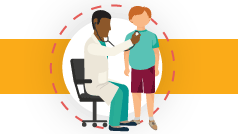Key points
- Childhood obesity is a complex condition with serious and costly consequences.
- Family Healthy Weight Programs (FHWPs) are safe, effective treatments for childhood obesity.
- State and local organizations can establish policies and activities to implement, spread, and sustain FHWPs.

Background

More than 14 million US children have obesity, with significant disparities by income, race, and ethnicity. Poverty and access to quality health care, healthy affordable foods and beverages, and safe and convenient places for physical activity contribute these disparities.
Preventing and treating childhood obesity involves many elements, such as ensuring good nutrition and safe physical activity for all children. Another element is practitioners who follow recommendations to assess and treat children with overweight or obesity. A FHWP is one treatment option.
FHWPs can be delivered in a clinical or community setting by trained program staff, similar to other comprehensive disease programs such as diabetes prevention programs.
Many children and families cannot access a FHWP in their community. Obstacles to finding and joining a FHWP include insurance reimbursement, program availability and delivery systems, practitioner awareness and referrals, bias and stigma, and resources such as staff or space.
To make FWHPs sustainable and accessible to children and families most in need, consider the community's needs and assets. Also consider state policies regarding insurance coverage and priorities related to chronic disease prevention and treatment.
Potential State Activities
All steps below are necessary to assess state readiness and gaps.
Summarize key gaps, opportunities, and findings from an assessment of the state's child obesity-related disparities and existing FHWP capacity.*
- Identify disparities in childhood obesity, such as by race or ethnicity, income, urban or rural, or by community or geographic area.
- Identify FHWPs in your state.
- Identify FHWP needs, assets, and barriers as well as partnerships that could promote FHWP implementation, spread, and sustainment, in clinical and community settings.
- Identify and summarize existing state chronic disease programs, delivery models, and mechanisms for use. Determine which resources could be shared or aligned with FHWPs to reduce barriers or cost and increase sustainability. Because FHWP is a chronic disease program, consider if the resources such as staff, space, and funding used for any chronic disease program could be shared. Examples of chronic disease programs with existing infrastructure may include diabetes prevention, falls prevention, arthritis, and hypertension.*
Review and summarize key opportunities and gaps in current programs.*
- Review current state health insurance plan language as well as billing and coding for child obesity screening and treatment. Include Medicaid and Children's Health Insurance Program (CHIP) and potentially state employee health plans. Identify areas for improvement to be consistent with clinical practice guidelines and healthcare quality improvement.*
- Assess child obesity professional development and quality improvement opportunities for evidence-based child obesity care, such as Continuing Medical Education (CME), Continuing Education (CE) for other clinical and professional staff, Extension for Community Healthcare Outcomes (ECHO) training modules, and webinars, or through Managed Care. Assess whether these include training on bias and stigma, motivational interviewing, or other evidence-based clinical decision support tools.*
- Build, or strengthen and formalize partnerships that will lay the groundwork to implement, spread, and sustain child obesity prevention and treatment. Compile partnership opportunities and needs. +
- Start or expand a state group to promote policies and strategies that support child obesity prevention and treatment, including a plan for sustaining FHWPs.+
- Align FHWP implementation efforts, infrastructure, and resources, such as staffing and space, with other chronic disease delivery models.+
- Update state health insurance plan language and billing mechanisms to improve coverage and reimbursement of child obesity assessment and treatment, including FHWPs, using findings from the assessment.
- Develop marketing, messages, and educational tools for families, caregivers, and health care professionals, such as a medical coding guide to support implementation.+
- Facilitate access to and uptake of professional development activities, such as CMEs, CE, ECHO modules, or through an ACO. Use findings from the assessment and summary to increase learning opportunities.+
- Work with local, state, or national partners to provide learning or quality improvement opportunities in your state.+

Potential Local Activities
Prepare for FHWP implementation
This implementation framework may help. All steps below are necessary to assess local readiness and gaps.
If others are implementing FHWPs, engage with their leaders to promote collective learning, assessments, and partnership development. This could be done through a pre-implementation learning collaborative.*
Collaborate with your community to assess obesity-related needs and assets, using data such as the CDC/ATSDR Social Vulnerability Index, Child Opportunity Index, state or local obesity prevalence, or resources that support child obesity prevention and treatment. Use findings to identify implementers, referral resources, or sites for program delivery.*
- Include an explicit process to understand current access to FHWPs for people from different cultures, people with low incomes, and people living in urban or rural areas.*
- Summarize key gaps, opportunities, and findings.*
Build or strengthen and formalize local partnerships to lay the groundwork to implement FHWPs and identify a partner organization that will implement the FHWP.*
Work with your implementing partner to assess, develop, and summarize:
- Technical assistance needs, readiness, feasibility, and resources to procure, carry out, and sustain a FHWP.*
- Plans for future FHWP implementation based on the above assessments.*
- Foundational infrastructure supports, such as funding, staff and space, and strategies to ensure accessibility. Challenges to accessibility can include several contextual factors.
Procure or get access to the best-fit evidence-based intensive FHWP, including curriculum and training, and prepare for implementation. Best-fit means matching partner and participant characteristics with the program. Often this is based on staff needed, participant ages, cultural and linguistic adaptation needs, physical space resources, technology, and cost.*
Support and Implement FHWP
All steps are necessary for successful implementation.
Engage with others who are implementing FHWPs to facilitate collective learning, quality improvement, and partnership strengthening, such as through participation in an implementation learning collaborative. This is a shift from pre-implementation to implementation. Activities could be continuing pre-implementation collaborative or joining a different implementation collaborative.+
Continue community collaborations and partnerships to support FHWP recruitment, retention, and sustainability, for example, through a community advisory board.+
Work with partners to implement an evidence-based FHWP using a FHWP-specific training, curriculum, materials, and resources.+
- Select and train staff.*
- Find appropriate physical space.*
- Address roadblocks that prevent fair access as identified in the pre-implementation assessment.*
Include the following for successful implementation:
- A pilot or phased approach and quality improvement process.
- Accessibility considerations, using knowledge gathered in the pre-implementation phase to provide specific support for potential participants' and partners' needs.
- Ongoing staff training, technical assistance, and other resources needed to sustain the FHWP.
- Plans for tracking implementation with outcomes, such as reach, engagement, adoption, and sustainability. Gather more feedback through focus groups or formal assessments such as surveys and adapting the program when necessary to improve local fit.

Working together
Examples of groups using CDC-recognized programs.
YMCA of Metropolitan Milwaukee Supports FHWP
Weight-management program for children 7 to 13 years old focuses on healthy eating, physical activity, and behavior change to empower children, and families, to live a healthier and active lifestyle.
FHWP for Children at Denver Health
Example of a FHWP called Mind, Exercise, Nutrition... Do It! (MEND) for children ages 7 to 13 in a healthcare system.
COMMIT!
CDC is partnering with the National Association of Community Health Centers to increase implementation of an evidence-based FHWP in Federally Qualified Health Centers.
Resources
United States Preventive Services Taskforce Child Obesity Screening Recommendation
Guidance for primary care providers in screening for obesity and referring to comprehensive, intensive behavioral weight management interventions.
CDC-Recognized Family Healthy Weight Programs
List of family healthy weight programs that meet screening criteria.
Equitable Implementation Guide, January 2023
Obesity professional development and quality improvement
Childhood Obesity Education for Healthcare Professionals
Modules, webinars, and podcast.
Tools for Education and Training in Obesity Prevention and Management
Interactive toolkit and modules for all levels of professional learning.
Children and Adolescent Obesity Treatment
Guide to evaluation of and treatment options for obesity in children and adolescents.
Obesity Treatment and Management Projects that Optimize Healthcare
Projects that improve quality of care, promote best practices, and support comprehensive multi-disciplinary pediatric health care teams.
Insurance plan review and obesity toolkit examples
Health plan guidance on coverage of obesity related care
Carriers are not allowed to exclude anti-obesity medications or other obesity treatments based on an exclusion or carveout. Refer to Carrier Letter February 2022, Carrier Letter 2023, and Technical Guidance March 2022.
Child and Adolescent Toolkit for Healthcare Providers
Activity and nutrition tools for healthcare providers. Includes summaries of recommendations related to child and adolescent obesity.
State Health Insurance Plan Review from the STOP Obesity Alliance
Analysis by state of health care plan coverage for obesity prevention and treatment.
Definitions
Childhood obesity prevention can occur across clinical and community settings by promoting and increasing access to opportunities for healthy eating and active living. Prevention includes supporting children and families in establishing or maintaining healthy sleep patterns, reducing stress, and increasing coping skills. Prevention may also include accessing high-quality early care and education or social assistance programs, such as the Special Supplemental Nutrition Program for Women, Infants and Children (WIC).
Childhood obesity professional development refers to adult professional learning around childhood obesity prevention and treatment using evidence-based learning approaches, treatment guidelines, and evaluation. Childhood obesity professional development should include training on bias and stigma, motivational interviewing, evidence-based Clinical Practice Guidelines, and clinical decision support tools.
Childhood obesity treatment is a continuum of care based on severity of obesity and co-occurring conditions. Treatment may include Family Healthy Weight Programs and other evidence-based treatments such as anti-obesity medications and bariatric surgery. Patient and family preferences, context, culture, access, and availability play an important role in shared decision-making about treatment options between care providers and families.
Accessible implementation addresses:
- Participant recruitment, including linking local health care and community organizations for referrals.
- Participant attendance and retention, including factors such as transportation, childcare, and time of program delivery.
- Costs to implementing partners, participants, and families.
- Social drivers of health, which may result in providing social asset resources such as lists of local food resources or free places to get physical activity.
- Adaptations for cultural and linguistic context.
- Training to avoid obesity bias and stigma.
FHWP is an intensive health behavior and lifestyle treatment program focused on nutrition, physical activity, and behavior change strategies. FHWPs are comprehensive and curriculum-based for children ages 2 to 18 years and their caregivers. Programs include 26-plus hours of intervention contact over 2 to 12 months. CDC-recognized FHWPs are research-tested and packaged with materials and training necessary for implementation. Other groups may refer to FHWPs as intensive health behavior and lifestyle treatment (IHBLT) programs or pediatric weight management interventions (PWMIs).
Insurance plan review involves reviewing the benefit and coverage language of health insurance plans for child obesity screening, assessment, and treatment. This should be a review of state health plans including Medicaid, Children's Health Insurance Program (CHIP), and state employee health plans. The review should include assessment of coverage for:
- Screening and assessment for obesity-related conditions.
- Counseling using motivational interviewing for nutrition, physical activity, and weight-related health behaviors.
- Multidisciplinary care from providers, such as registered dietitians, behavioral health specialists, community health workers, health educators, social workers, exercise specialists, health coaches, and physical therapists (without annual limits/caps).
- Primary care and follow-up weight management.
- Subspecialist care for obesity and related conditions.
- Anti-obesity medications and metabolic and bariatric surgery.
- Intensive behavioral lifestyle treatment programs such as FHWP for children and other comprehensive obesity treatment programs, such as diabetes prevention programs for adults.
Quality improvement opportunities in childhood obesity prevention and treatment improve adherence with evidence-based guidelines for screening, assessment, and treatment. Improvements help treatments become patient-centered, free from bias and stigma, and culturally competent. A framework can be used to systematically standardize processes and structure to reduce variation, achieve more predictable results, and improve outcomes.
Cross-cutting areas
Communication tips to support program efforts.
Evaluation framework for making evaluations useful, feasible, ethical, accurate, and culturally responsive.
Health Access tools to help remove barriers to health.
Additional priority strategies
Breastfeeding Continuity of Care
Increasing Physical Activity Through Community Design
Early Care and Education (ECE) Policies and Activities
